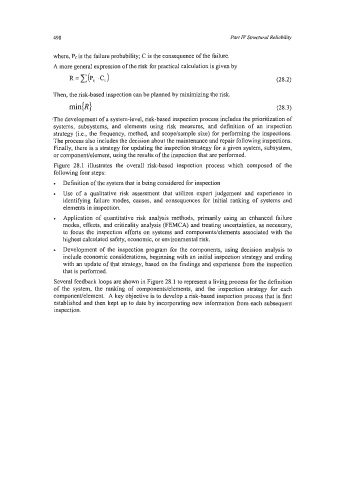Page 522 - Marine Structural Design
P. 522
498 Part IV Structural Reliabiliiy
where, Pf is the failure probability; C is the consequence of the failure.
A more general expression of the risk for practical calculation is given by
(28.2)
Then, the risk-based inspection can be planned by minimizing the risk.
min[R) (28.3)
The development of a system-level, risk-based inspection process includes the prioritization of
systems, subsystems, and elements using risk measures, and definition of an inspection
strategy (i.e., the frequency, method, and scope/sample size) for performing the inspections.
The process also includes the decision about the maintenance and repair following inspections.
Finally, there is a strategy for updating the inspection strategy for a given system, subsystem,
or component/element, using the results of the inspection that are performed.
Figure 28.1 illustrates the overall risk-based inspection process which composed of the
following four steps:
Definition of the system that is being considered for inspection
Use of a qualitative risk assessment that utilizes expert judgement and experience in
identifying failure modes, causes, and consequences for initial ranking of systems and
elements in inspection.
Application of quantitative risk analysis methods, primarily using an enhanced failure
modes, effects, and criticality analysis (FEMCA) and treating uncertainties, as necessary,
to focus the inspection efforts on systems and components/elements associated with the
highest calculated safety, economic, or environmental risk.
Development of the inspection program for the components, using decision analysis to
include economic considerations, beginning with an initial inspection strategy and ending
with an update of that strategy, based on the findings and experience from the inspection
that is performed.
Several feedback loops are shown in Figure 28.1 to represent a living process for the definition
of the system, the ranking of components/elements, and the inspection strategy for each
component/element. A key objective is to develop a risk-based inspection process that is first
established and then kept up to date by incorporating new information from each subsequent
inspection.

